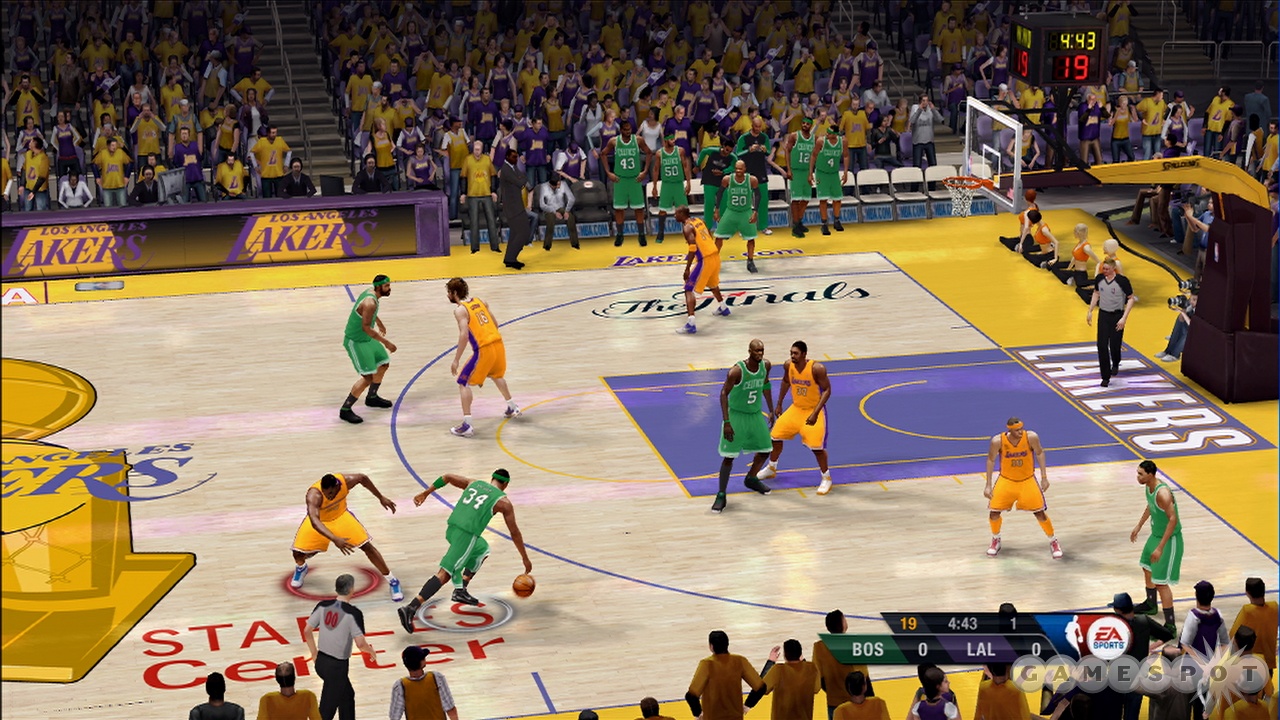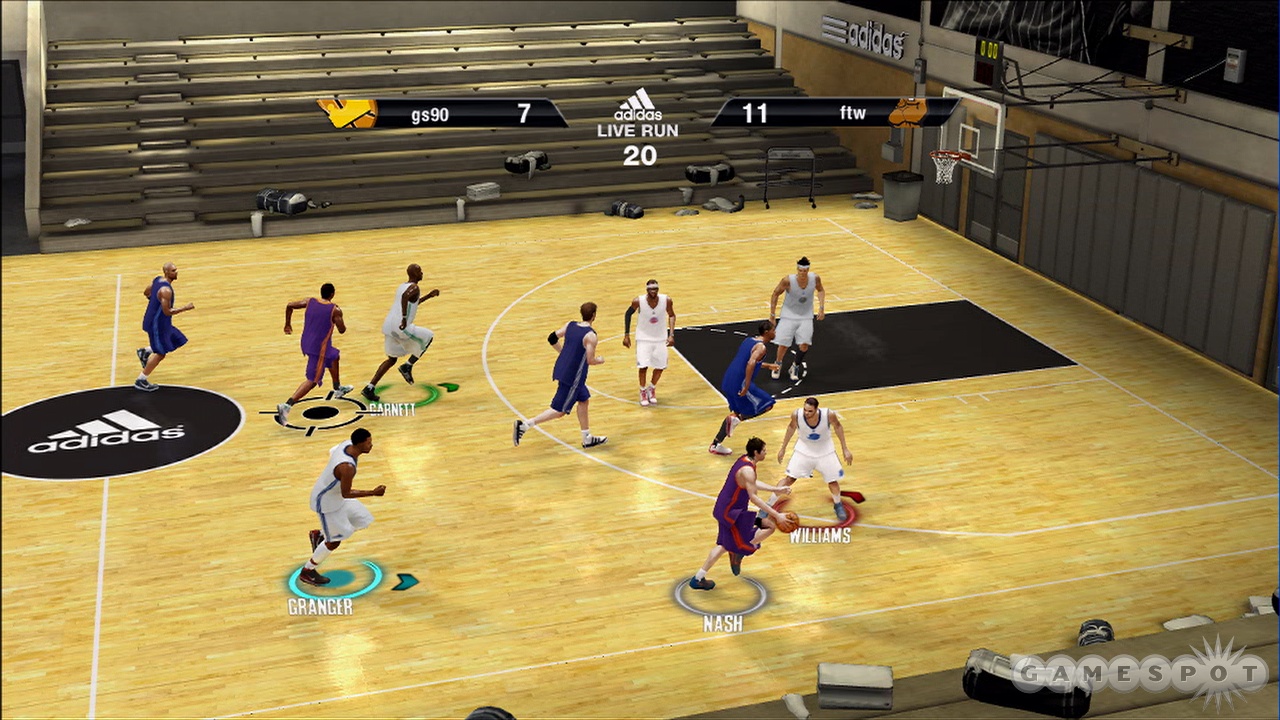Down by just a point with only 20 seconds left in the game, you take control of Kobe Bryant and begin to size up the inconsistent defender standing a few feet in front of you: Vince Carter. You rhythmically dribble the ball between your legs as your overmatched opponent begins to rock uneasily on his heels. With five seconds left, you pick up the ball and begin your shooting motion. Carter leaps toward you with his arms outstretched, trying to block your game-winning attempt. And just when the other defenders put their guard down for a split second, Pau Gasol flashes across the paint, receives a perfectly placed pass from Kobe, and dunks the go-ahead points as the buzzer sounds. The best moments of NBA Live 10 mirror the thrill and intensity of the real sport, allowing you to make strategic decisions on the fly to take advantage of your opponent's mental lapses. The exciting action does have some noticeable problems, though. The ball physics are maddeningly unpredictable and the basketball IQ of most players is even lower than that of Josh Smith's. But there's enough strategy and high-flying action to make this a fun basketball simulation, despite a few missteps.
The most interesting new element of NBA Live 10 is the ability to play along with the current NBA season from the comfort of your living room. Live's Dynamic DNA, in which player attributes are updated daily to reflect real-world changes, is integrated into the Season mode, allowing you to play through the real-life events with your chosen team. This means that not only are real-world statistics carried over into your season, but injuries, trades, and every other major news story is carried over as well. Last year, Dynamic DNA's impact was only noticeable to the most hardcore basketball fanatics. The slight tweaks to player attributes throughout a season were a neat feature, but only the most attentive players would recognize the minuscule changes to their favorite NBA stars. However, by integrating Dynamic DNA with real-world events during the season, it is much more apparent to casual fans and provides a compelling reason to stick with the game all the way through the Finals.
Thankfully, the on-court action does a good job of emulating the real thing. Each team has a huge array of plays it can call--on the offensive or defensive end--and this creates a much more strategic experience than in the past. You can bring up your playbook at the push of a button, and it's incredibly satisfying to recognize what your opponent is doing, select the optimal play, execute it flawlessly, and get a wide-open basket. When you would rather freelance, the pick-and-roll game is just as easy to pull off. By just holding a button, you can order your teammate to set a pick for you, and from there, you can make your players roll toward the hoop or step back for a jumper. It's easy to use and difficult to defend, so just like in real life, once you master this formula, you can burn a team over and over again.
If you would rather score on your own, Live does a good job of emulating the "stand and watch" offense in the real league. You can spread your teammates to the corners while you go one-on-one with a defender, trying to take him off the dribble for a spectacular dunk. The right stick is used to control your dribble, so you can methodically cross the ball back and forth before you see an opening for an attack. If you don't time your move right, though, your defender will be able to hold you up or even steal the ball away, which creates a cool risk-versus-reward dynamic. You can also move your teammates manually while you're at the top of the key, making them run curls or backdoor cuts to get open. Unfortunately, once you initiate this manual control, you are forced to pass the ball to them. This means you won't be able to use this feature to set picks to get another player open. Furthermore, if you aren't manually controlling your teammates or calling plays, everyone has a tendency to just stand around. They will move lazily across the paint without any direction and rarely get open or contribute much on the offensive end.

Disinterested teammates aren't the only problem with NBA Live 10. The basketball itself is the biggest issue. It simply does not act like a real rubber ball. Players frequently clip right through it, making steals, rebounds, and blocks much more difficult than necessary. If you know that TJ Ford is trying to force a pass to Danny Granger on the low block, you can position a defender between the two. However, more often than not, the ball will pass clean through your defender, which is incredibly frustrating. The same ethereal properties exist when you're trying to block or go for a steal, and you'll watch in horror as your hand passes clean through the ball while your opponent scores another bucket. Furthermore, players lose interest as soon as you slap the ball away from them. In one game we played, Deron Williams poked the ball away from Tony Parker, and the French point guard just stood still, whereas in real life, he would almost certainly have dove on the floor to recover the loose ball.
Online Leagues let you create an NBA in which every team is controlled by one of your buddies. You can have up to 30 members, and the commissioner can mess with settings, such as abolishing trades or allowing owners to compete in a fantasy draft to sculpt their own perfect franchise. There's also a mode called Adidas Live that replaces the disappointing Be a Pro mode from last year's edition. This is a five-on-five competition where every person selects just one NBA star to play as, and you can't switch to another player midgame. If you can't get enough of your friends to play, the computer will take control of any extras players. Although you cannot create your own character in this mode, it's still a lot of fun. Setting picks for your friends or running a perfect backdoor cut to get open feels a lot like playing a pick-up game in real life, and without fouls getting called, the game moves at a good pace. It's a shame there isn't more depth in this mode because from a basketball perspective, it's a really good time. But without any long term incentives or the ability to create your own player, it feels like a missed opportunity.

The presentation has been overhauled this year to create an energetic atmosphere that builds on the excitement on the court. The crowd cheers with vigor at all the appropriate times, making an explosive dunk that much more exhilarating. Bench players get a little too into the action at times--it doesn't make much sense for a veteran team like the Spurs to be going bonkers in the first quarter of a meaningless game--but it's still cool to see your inactive teammates cheering on your efforts. Players usually move realistically, whether they're pulling back for a step-back three or shaking their heads in disgust at a bad call. There are some awkward movements--usually when you go up for a rebound or block--but the animation is generally smooth. The commentary isn't quite as authentic, though. Marv Albert and Steve Kerr provide the occasional insight, but they are often inaccurate and usually slow. It's just baffling when you cut the lead from five down to two points and hear, "Troy Murphy has evened the score." The excitement of the crowd makes listening to the action worthwhile, but don't expect the commentators to add much to the atmosphere.
NBA Live 10 won't change the way you play digital basketball, but it's a good representation of the sport. Playing through a Dynamic DNA-enhanced season is engaging, letting you live through the peaks and valleys of the real season. There are a few quirks in the action, such as a glitchy ball and sometimes-disinterested teammates, but the action is pretty sharp. The pick-and-roll system is easy to take advantage of, and the huge amount of plays at your disposal make the game more strategic than previous basketball sims. Despite a few faults, NBA Live 10 is a fun game and a strong addition to the franchise.